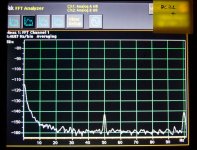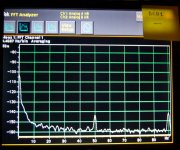What is that noise floor?Great. I couldn't wait, so I ordered everything today, except for the 170's. If the version with BF256's stays below the noise floor of my measurement preamp I see no reason to order them at all; if it doesn't, we'll see...
I'm bringing up a preamp and testing sections in isolation. I got as far as some ~30mA current generators and found that I need a preamp ahead of the Audio Precision to resolve the noise developed across a 200 ohm test resistor---attempting to do root-difference-of squares is too uncertain due to the Ap self noise.
What I sometimes do for that is a simple SK170 with a 1k drain resistor and two 9V batteries in series, a.c. couple to the gate. A gain of about (-)25, typically.
BTW, the 170 drain and source are interchangeable, so as you pointed out that you are tying gate to source, you don't even have to reverse the part if used in lieu of the 256.
What is that noise floor?
I don't have such fancy things like AP gear at hand, just a soundcard (ESI Juli@) and a simple preamp... Measurements and schematic here: LM317 regulator under test preamp.org
What is that noise floor?
It is among the quietest regulators I have tested -- see this chart on the LinearAudio website:
http://linearaudionet.solide-ict.nl/sites/linearaudio.net/files/V4 JW F7.pdf
I meant Preamp's measurement setup, not the regulator. Yes, I have seen those curves.It is among the quietest regulators I have tested -- see this chart on the LinearAudio website:
http://linearaudionet.solide-ict.nl/sites/linearaudio.net/files/V4 JW F7.pdf
Great. I couldn't wait, so I ordered everything today, except for the 170's. If the version with BF256's stays below the noise floor of my measurement preamp I see no reason to order them at all; if it doesn't, we'll see...
Since you are using a Zener Vref, but with a big 1000uF filter across it as I recommended, noise should remain low. That much is usually enough to level a Plain Jane Zener's noise in a 70's HP spectrum Analyzer grass floor to give you a rough idea. Jack's measurement sample was V1.1 that had a Norton Vref i.e. a CCSed resistor with 220uF across it. If you want best of both worlds (low impedance active stable ref & lowest noise) try find a TC compensated Zener (good luck if not ordering in quantity for building military gear) or stack a couple of LM329s. But wait to see if you can resolve any worse noise with your test gear first. As I wrote before your voltage output won't be that of your Vref only. Its plus 1Vbe and whatever voltage level that error amp transistor sits on. I.e. if its different than ground. In the standard reg its ground.
Jack's measurement sample was V1.1 that had a Norton Vref i.e. a CCSed resistor with 220uF across it.
Do you have a post number handy?
As I wrote before your voltage output won't be that of your Vref only. Its plus 1Vbe and whatever voltage level that error amp transistor sits on. I.e. if its different than ground. In the standard reg its ground.
I'm fine with 16V. Two LM329 would be closer to 15V though.
Where else should one refer the error amp to? An Emitter resistor would probably raise Vout a little...?
P.S. Here are two pictures from a Tek analyzer that a member from Spain once used to measure the rails noise on a Mezmerize DCB1. This is similar to yours (V1.0 family symmetrical, same MOSFETs, with K170s though, but LEDS instead of Zener with 100uF across them). I hope this will give you some kind of reference for your own measurements. I don't know what was his 0dB level setting in dBV though. Maybe I see a dBu mark shadow to the upper left. 0.7746 volt = 0 dBu. Good luck.
Attachments
Do you have a post number handy?
I'm fine with 16V. Two LM329 would be closer to 15V though.
Where else should one refer the error amp to? An Emitter resistor would probably raise Vout a little...?
Look for thread "SSLV1.1 builds & fairy tales"
I haven't looked in what your cross referencing, to allow more VDS for the BF256, adds or not. There is a 1k tail resistor I can see. 5mA could add 5V. Wouldn't use less to bias a Zener well. Better more. But that only sits the JFET. Don't use an emitter resistor, it worsens the spec. What your simulation is giving for Vout? Is there something added or subtracted from referencing across?
Look for thread "SSLV1.1 builds & fairy tales"
Will do.
I haven't looked in what your cross referencing, to allow more VDS for the BF256, adds or not. There is a 1k tail resistor I can see. 5mA could add 5V. Wouldn't use less to bias a Zener well. Better more. But that only sits the JFET. Don't use an emitter resistor, it worsens the spec. What your simulation is giving for Vout? Is there something added or subtracted from referencing across?
Vout stays the same, since the bipolar is still referenced to ground. It's only the JFET-CCS that's connected to the opposite rail and thus has 16V (in my case) more to work with. I increased the resistor to 1k so that the FET doesn't have to stem the whole 16.7V.
EDIT: Doesn't look good at switch-off, breakdown voltage of BC550 is 5V only, no? I'll add clamp diodes. Thanks for pointing that out!
Shouldn't I? From what I've read so far they seem to be your preference. The abovementioned TO-220's would save some board space, but I'm a fan of beefy devices...
Hello Preamp
Would you care to upload your models so we can play with your sim ?
Best
Ricardo
With how many mA you bias the Zener?
However much the JFET will yield, wich is 6-13mA according to the datasheet. Would be ~200mW for the upper case and no additional resistor.
Would you care to upload your models so we can play with your sim ?
They're from Bob Cordell and LTspice's own, IIRC. Here you go:
Code:
.model 1N4004C D (IS=500p RS=0.12 BV=400 IBV=5.00u CJO=40p M=0.35 N=1.6 TT=4u mfg=CA112310)
.model BF256B NJF(Beta=1.5m Betatce=-.5 Rd=1 Rs=1 Lambda=4.2m Vto=-2.3 Vtotc=-2.5m Is=33.57f Isr=322.4f N=1 Nr=2 Xti=3 Alpha=311.7u Vk=243.6 Cgd=2.132p M=.3622 Pb=1 Fc=.5 Cgs=2.104p Kf=23.06E-18 Af=1)
.model GREEN D(Is=1e-19 N=2.0 Rs=1.5 Eg=2.23 Tnom=27deg)
.model IRFP9240 VDMOS(pchan Rg=3 Vto=-4 Rd=200m Rs=50m Rb=100m Kp=8.2 Lambda=.10 Cgdmax=1.8n Cgdmin=.07n Cgs=.77n Cjo=.77n Is=76p mfg=International_Rectifier Vds=-200 Ron=500m Qg=44n)
.model BZX84C15L D(Is=.6n Rs=.5 Cjo=110p nbv=6 bv=15 Ibv=1m Vpk=15 mfg=OnSemi type=Zener)
.MODEL BC550C npn IS=45e-15 BF=689 VAF=162 IKF=0.09 ISE=4600e-15 NE=2 NF=0.9965 RB=167 RC=1 RE=0.04 CJE=18.7e-12 MJE=0.35 VJE=0.75 CJC=6.2e-12 MJC=0.25 VJC=0.4 FC=0.5 TF=595e-12 XTF=10 VTF=10 ITF=1 TR=10e-9 BR=12.2 IKR=0.34 EG=1.2 XTB=1.65 XTI=3 NC=0.996 NR=1.0 VAR=120 IRB=7e-5 RBM=1.1 XCJC=0.6 ISC=5e-15 mfg=CA030111 vceo=45 icrating=100m
.MODEL BC560C pnp IS=60e-15 BF=900 VAF=160 IKF=0.10 ISE=70e-15 NE=1.42 NF=1 RB=170 RC=1.0 RE=0.05 CJE=19e-12 MJE=0.3 VJE=0.75 CJC=3.9e-12 MJC=0.3 VJC=0.75 FC=0.5 TF=600e-12 XTF=7 VTF=4 ITF=0.45 TR=10e-9 BR=3 IKR=0 EG=1.1 XTB=1.5 XTI=3 NC=2 ISC=0 mfg=CA030211 vceo=45 icrating=100m
Last edited:
I'm fine with 16V. Two LM329 would be closer to 15V though.
Some recent enough LM329DZ I have in my drawer are measuring almost all at 7.1V. That X2 + 0.6Vbe = 14.8V
They are from Mouser. The data sheet says they are within tolerance though. Maybe the room temperature difference between Canada and Greece at this time of year. I had measured them after I checked the Fluke with a Scott's AD581 10V Vref chip first, and it was bang on.
Attachments
- Status
- This old topic is closed. If you want to reopen this topic, contact a moderator using the "Report Post" button.
- Home
- Amplifiers
- Power Supplies
- The simplistic Salas low voltage shunt regulator


